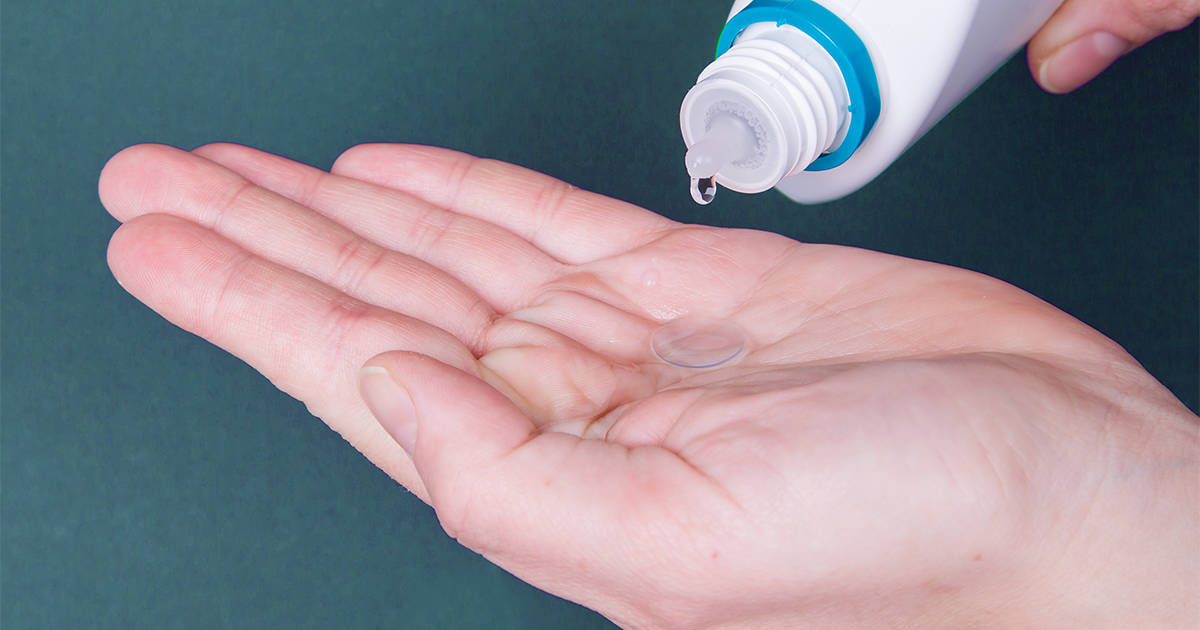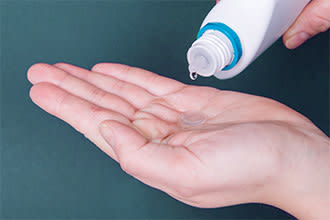Lens care: Cleaning, disinfection and storage

Caring for soft contact lenses is essential to keep your eyes healthy, comfortable and seeing well.
Fortunately, it’s easy.
One-bottle care systems and disposable contact lenses mean that proper lens care involves much less time, expense and trouble than it did years ago.
Before we get started, understand that you should consult your optometrist before you switch your contact lens care regimes. Some products are not compatible with each other, or with certain contact lenses. Using incompatible products can ruin your contact lenses or harm your eyes.
To make sense of all the bottles and boxes, it helps to know what steps are required to care for soft contacts.
The basics of soft contact lens care

To clean contacts with a multipurpose solution, place the lens in the palm of your hand, apply a generous amount of solution and gently rub the lens against your palm with your pointer finger, using a back-and-forth (not circular) motion.
Regardless of which type of soft contact lens care system your optometrist recommends, follow these essential steps:
Wash your hands so that you don't transfer dirt and germs to your eye. Try to avoid moisturising soaps, as they are not good for contact lenses. Dry your hands with a lint-free (linen) towel.
Remove one lens and clean it with the recommended solution. Cleaning removes eye-produced build up, cosmetics and other debris that impairs lens comfort. Apply the cleaning solution liberally and rub the lens in the palm of your hand — even if you are using a "no-rub" solution.
Rinse the lens to remove the loosened debris, making sure to take as long as the package directs: rinsing is an important step.
Place the lens in your clean lens case or lens holder and fill with fresh solution; don't "top off" your old solution. Disinfecting kills microorganisms on the lens. Disinfection time varies from product to product; check the package for details.
Repeat steps two through four for your other lens.
Beyond cleaning, rinsing and disinfecting
Protein. Depending on what kind of contact lenses you wear and how much protein your eyes deposit on your contacts, your optometrist may recommend you use a product for protein removal.
While cleaning them does remove some protein, it can still build up on your lenses and make them uncomfortable. That's why the longer you wear lenses before replacing them, the more likely you are to need a protein remover.
For example, if you wear disposables, you probably won't need one; but if you wear the kind of lenses that are replaced only once or twice a year, you definitely will.
Products for removing protein include enzymatic cleaner and daily protein removal liquids.
Eye dryness and irritation. Use contact lens eye drops to lubricate your eyes and re-wet your lenses as needed for comfort.
Eye sensitivity and allergies. A small percentage of lens wearers develop an eye allergy to the chemicals present in contact lens solutions. If this is the case with you, switch to a preservative-free contact lens cleaning system.
The products: Cleaning, rinsing and disinfecting solutions
Saline solution is for rinsing and storing contact lenses when using a heat or UV disinfection system. You also may need it for use with enzymatic cleaning tablets or cleaning/disinfecting devices. Saline is only a rinsing agent; it does not disinfect.
Daily cleaner is for cleaning your contact lenses. You place a few drops in the palm of your hand and carefully rub the lens for as long as directed (usually about 20 seconds), making sure to clean both sides of your lenses. Use other products for rinsing and disinfection.
Multipurpose solution is for cleaning, rinsing, disinfecting and storing your contact lenses. Clean your lenses as you would with daily cleaner, then rinse and disinfect, all with the same solution; or rinse the lenses twice, then place them in the clean lens case with solution to clean and disinfect. When you are ready to wear the lenses, rinse them again. With multipurpose solutions, often no other lens care products are needed.
Hydrogen peroxide is a cleaning and disinfection solution. With this product, you place your lenses in the provided basket and rinse them, then place the basket in its cup and fill the cup with solution to clean and disinfect your lenses.
Some lens holders for hydrogen peroxide systems have a built-in neutraliser (to convert the hydrogen peroxide to water, so it doesn't sting your eyes), but with others you need to add a neutralising tablet.
After the disinfection and neutralising step is completed, you can remove the lenses from the case and put them on.
Never rinse your contacts with hydrogen peroxide solution and apply them directly to your eyes without completing the entire disinfecting and neutralising step. Doing so can cause a painful chemical injury to the eye.
Cleaning/disinfecting devices will, as you would expect, both clean and disinfect your contact lenses. Depending on how the brand is designed, cleaning is accomplished with either ultrasonic waves or subsonic agitation, whereas disinfection occurs via multipurpose solution or ultraviolet light.
Instructions for using these devices are all a little different. In general, you first rinse the lenses, using either saline or multipurpose solution as directed. One brand requires rubbing with the saline, but most are no-rub. Next, put your contact lenses in the device and fill it with the same type of solution as for the rinse. Place the lid on the device and plug it in to clean and disinfect your lenses.
The products: protein removers, eye drops and options for sensitive eyes
Enzymatic cleaner is for removing protein from your contact lenses, usually on a weekly basis. You use the tablets with saline solution or disinfecting solution (multipurpose or hydrogen peroxide), as directed.
Before using enzymatic cleaner, clean and rinse your contacts using other products. Fill your lens case or vials (as directed) with solution, then drop an enzymatic tablet in each lens well or vial. Wait for them to dissolve, then add your contacts. Leave them in for the required time (usually 15 minutes).
Afterwards, disinfect with another product if necessary. Certain enzymatic cleaners allow you to skip the disinfection step if you use disinfecting solution rather than saline, but that's not always the case; check the enzymatic cleaner packaging for details.
Daily protein remover also removes protein from your lenses but it's in liquid form and you use it daily. You use it during disinfection with multipurpose solution.
Before using a daily protein remover, you clean and rinse your contacts using other products. Fill both wells of your lens case with multipurpose solution, then add a drop of daily protein remover to each.
Disinfect your lenses as usual.
Eye drops for contact lenses are for lubricating your eye and re-wetting your contacts. Make sure to choose a brand that is safe for contact lenses. Eye drops that aren't mean for contact lenses can affect how the lens fits and cause discolouration.
Products for sensitive eyes help people who have allergic reactions to contact lens solutions. Allergies can crop up even if you've been using the same products for years without difficulty.
Symptoms may include itching, tearing, foreign body sensation, burning, redness and eye discharge. It's important to see your optometrist if you're experiencing these symptoms, as they can have many causes.
Usually, switching to a preservative-free lens care system eliminates the problem. Some of these have what's called a "disappearing" preservative that's gone before the solution comes in contact with your eyes.
Be sure to pay close attention to the expiration dates on all contact lens solutions, particularly preservative-free solutions. Non-aerosol preservative-free saline, for example, should be discarded within two weeks after you open it to reduce the risk of contamination.
What's most popular? Ease of use.
Most soft contact lens wearers prefer multipurpose solutions for their contact lens care regime due to ease of use — only one product is required for cleaning, disinfecting and rinsing the lenses.
Sometimes hydrogen peroxide care systems are a better choice — especially if you develop discomfort problems when using multipurpose lens care products.
Shop brands
You may have noticed that shops like your chemist or supermarket sell own-brand contact lens care products, also known as "white label" products.
Usually, these white label products are considerably cheaper than name-brand products. But should you use them?
Sometimes white label products are made from older formulations, which don't offer the same advantages as newer products.
Also, sometimes the composition of white label lens care products are changed without notice, and the new formula might irritate your eyes.
Contact lens care: Essentials
Once you've decided which product you'd like to try, discuss your plans with your optometrist.
Don't switch brands until you determine that the new brand is compatible with your other products and with your contact lenses.
Regardless of which contact lens care products you use, remember:
Never touch solution bottle tips to any surface, including your body: this can cause contamination of the solution.
Avoid getting tap water on your contact lenses and accessories, as it can carry a microorganism called Acanthamoeba that causes serious eye infections.
Remember to clean your contact lens accessories (lens case, cleaning/disinfecting devices, enzymatic cleaner vials and so on) as directed.
After putting on your contacts, rinse the storage case with hot tap water and allow the case to air-dry with the caps off. As Acanthamoeba cysts may be present in tap water and can survive for years after drying, some optometrists recommend using only contact lens disinfecting or multipurpose solution for this step.
Discard your contact lens case every three months to reduce your risk of infection.
Most importantly, clean and disinfect your contact lenses every day.
If you wear extended wear contacts, clean and disinfect the lenses as soon as you remove them, unless they are designed to be discarded immediately after use.
Page published on Monday, 16 March 2020






